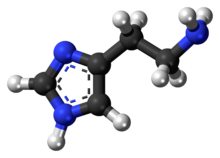**Chemical Properties and Synthesis**:
– Histamine base melts at 83–84°C.
– Hydrochloride and phosphorus salts form white hygroscopic crystals.
– Imidazole ring of histamine exists in two tautomeric forms.
– Histamine is derived from the decarboxylation of histidine.
– Enzyme L-histidine decarboxylase catalyzes the reaction.
– Histamine is normally protonated to a singly charged cation.
**Storage, Release, and Degradation**:
– Most histamine is generated in mast cells and basophils.
– Non-mast cell histamine is found in tissues like the brain.
– Histamine production by bacteria can cause foodborne illness.
– Histamine is degraded by diamine oxidase and histamine-N-methyltransferase.
– Single nucleotide polymorphisms at degradation genes are linked to disorders.
– DAO is expressed in epithelial cells of the small intestine mucosa.
**Regulation, Impact, and Mechanism of Action**:
– Histamine regulates physiological functions in the gut and acts as a neurotransmitter.
– Histamine primarily binds to G protein-coupled histamine receptors (H1-H4).
– Histamine plays diverse roles in the central and peripheral nervous systems.
– Reduction of IgE overproduction may lower allergen-triggered histamine release.
– Histamine-gated chloride channels produce inhibitory postsynaptic potentials in the brain.
**Physiological Roles and Effects**:
– Histamine is involved in 23 physiological functions due to its versatile binding properties.
– Histamine’s involvement in various functions is attributed to its chemical properties.
– Histamine has both stimulatory and suppressive effects that protect against convulsions, drug sensitization, and stress.
– Histamine plays a role in protecting against ischemic lesions.
– Histamine has been suggested to play a role in forgetting mechanisms.
**Medical Conditions and Research Studies**:
– Histamine therapy for multiple sclerosis is under study.
– Genetic variations in histamine degradation enzymes can lead to disorders.
– Histamine plays a role in the pathophysiology of schizophrenia.
– Histamine-induced wheal and flare can predict the clinical efficacy of antihistamines.
– Altered expression of histamine signaling genes in autism spectrum disorder.
Histamine is an organic nitrogenous compound involved in local immune responses communication, as well as regulating physiological functions in the gut and acting as a neurotransmitter for the brain, spinal cord, and uterus. Since histamine was discovered in 1910, it has been considered a local hormone (autocoid) because it lacks the classic endocrine glands to secrete it; however, in recent years, histamine has been recognized as a central neurotransmitter. Histamine is involved in the inflammatory response and has a central role as a mediator of itching. As part of an immune response to foreign pathogens, histamine is produced by basophils and by mast cells found in nearby connective tissues. Histamine increases the permeability of the capillaries to white blood cells and some proteins, to allow them to engage pathogens in the infected tissues. It consists of an imidazole ring attached to an ethylamine chain; under physiological conditions, the amino group of the side-chain is protonated.

| |

| |
| Names | |
|---|---|
| IUPAC name
2-(1H-Imidazol-4-yl)ethanamine
| |
| Identifiers | |
3D model (JSmol)
|
|
| ChEBI | |
| ChEMBL | |
| ChemSpider | |
| DrugBank | |
| ECHA InfoCard | 100.000.092 |
| KEGG | |
| MeSH | Histamine |
PubChem CID
|
|
| UNII | |
CompTox Dashboard (EPA)
|
|
| |
| |
| Properties | |
| C5H9N3 | |
| Molar mass | 111.148 g·mol−1 |
| Melting point | 83.5 °C (182.3 °F; 356.6 K) |
| Boiling point | 209.5 °C (409.1 °F; 482.6 K) |
| Easily soluble in cold water, hot water | |
| Solubility in other solvents | Easily soluble in methanol. Very slightly soluble in diethyl ether. Easily soluble in ethanol. |
| log P | −0.7 |
| Acidity (pKa) | Imidazole: 6.04 Terminal NH2: 9.75 |
| Pharmacology | |
| L03AX14 (WHO) V04CG03 (WHO) (phosphate) | |
Except where otherwise noted, data are given for materials in their standard state (at 25 °C [77 °F], 100 kPa).
| |
